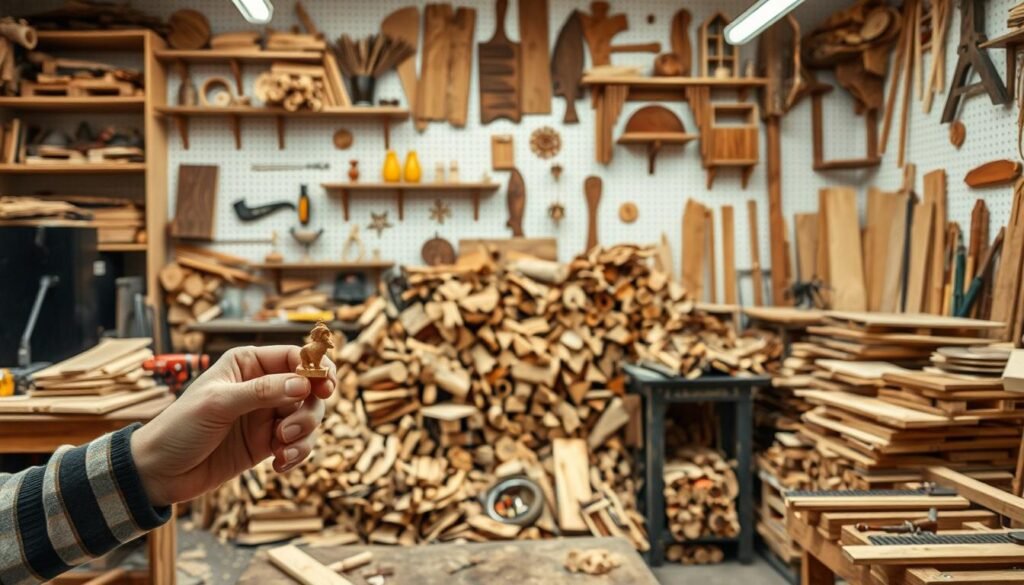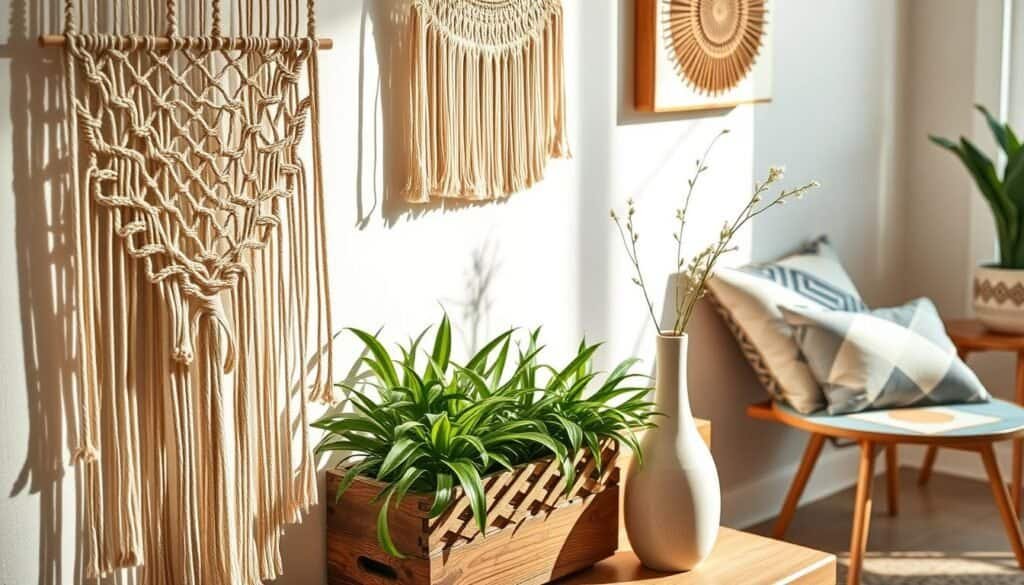Getting kids involved in creative activities is key for their brain growth. Fun woodworking projects are a great way to boost their creativity and design skills.
DIY wood projects teach kids to solve problems and improve their hand-eye coordination. They also learn the fundamentals of design and building.
Through these projects, kids enhance their critical thinking and creativity. This prepares them for success in many areas of life.
The Value of Hands-On Learning Through Woodworking
Woodworking is more than a hobby; it’s a great way to learn. It helps kids solve problems, think creatively, and think critically. Through woodworking, they can explore design, understand materials, and learn how to build things.
Projects like building wooden structures or toys encourage kids to think outside the box. They learn to measure, cut, and put things together. This improves their fine motor skills and hand-eye coordination. Woodworking also teaches kids about planning, patience, and not giving up.
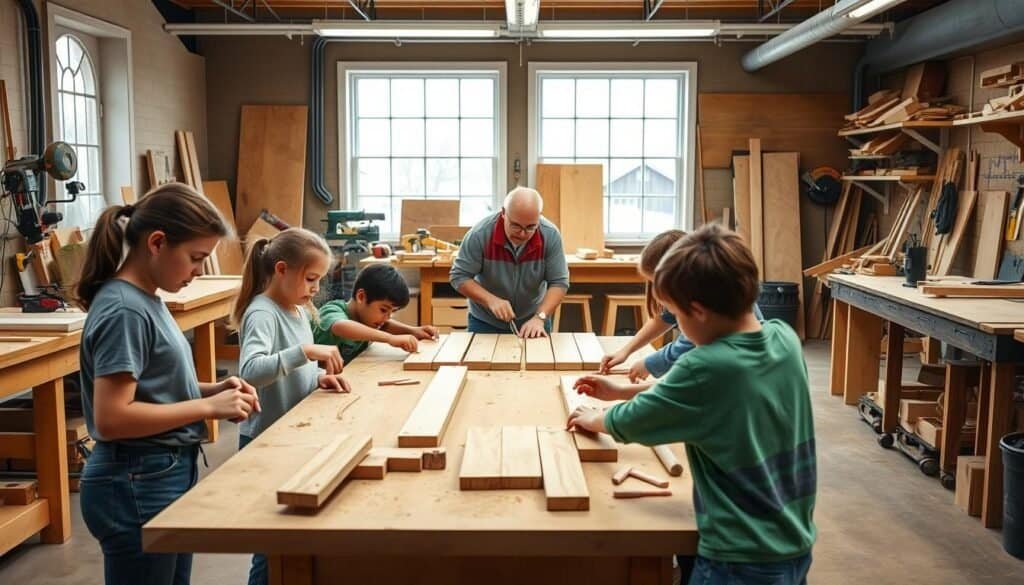
Creating something from scratch makes kids feel proud and accomplished. It teaches them about trying again and learning from mistakes. Adding woodworking to their education gives kids a rich learning experience that’s different from school.
Essential Tools and Materials for Kid-Friendly Woodworking
To make woodworking safe and fun for kids, picking the right tools and materials is important. Projects for beginners should teach them about woodworking and keep them safe.
Start by getting the tools and materials needed for woodworking. Kids need simple tools like a kid-safe saw, sandpaper, and a hammer. Easy projects use pre-cut wood, so kids don’t have to cut much.
Personal Protective Gear, Workspace Safety Items
Safety is the top priority in woodworking. Kids should wear safety glasses, a dust mask, and gloves. This protects them from sawdust and sharp edges.
Also, make sure the workspace is clean and safe. No clutter or tripping hazards allowed.
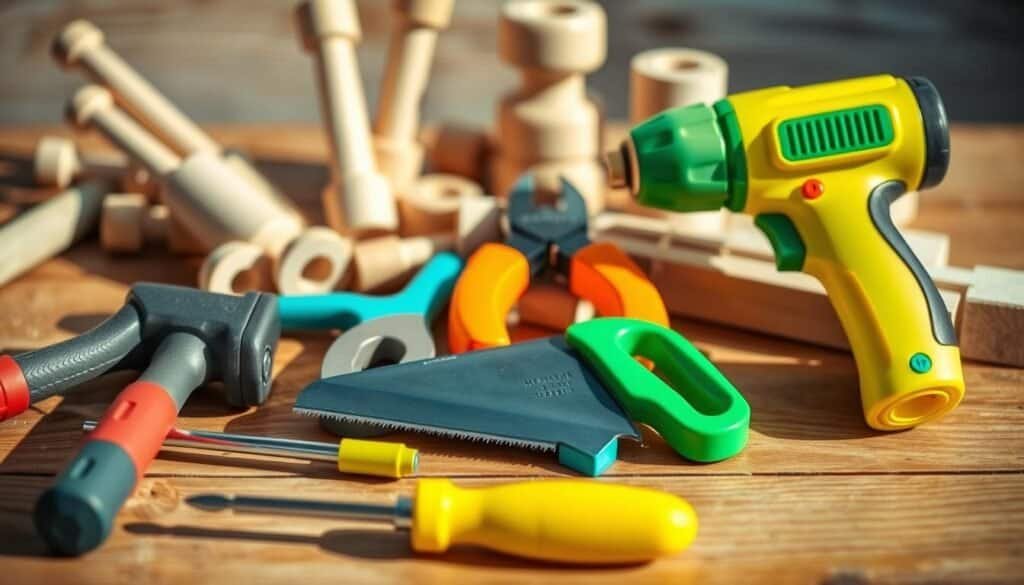
With the right tools and safety steps, kids can have fun making things. They learn about woodworking and become more responsible and aware of safety.
The main goal of woodworking for kids is to be fun and educational. By choosing the right tools and materials, parents and teachers help kids learn skills that will last forever.
Safety First: Creating a Secure Woodworking Environment
Safety is the most important thing when kids start woodworking. A safe space prevents accidents and teaches kids to handle tools responsibly.
Keeping tools safe is a big part of a secure woodworking area. Tools that aren’t being used should be locked away where kids can’t get to them.
Tool Storage Solutions
Good tool storage means using toolboxes with locks, pegboards with safety latches, and cabinets made for woodworking tools. These help keep the workspace tidy and safe.
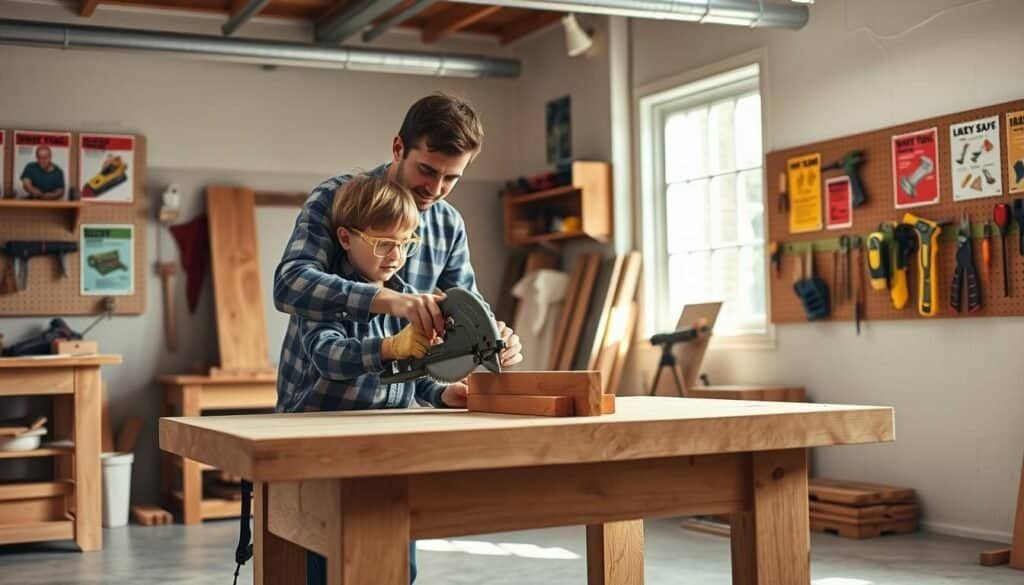
It’s also important for kids to wear safety gear like safety glasses, gloves, and dust masks. Teaching kids about safety gear and how to use it is key to keeping them safe.
With these safety steps, parents and teachers can make woodworking a safe and fun learning experience for kids. Kids can enjoy making their own projects while learning important skills.
Educational DIY Wood Projects That Teach Kids About Design
Building DIY wood projects is a great way for kids to learn about design. They get to explore design principles like balance and texture. Plus, they create something with their own hands.
One key part of DIY wood projects is the journey from idea to finished product.
From Sketch to Final Product
This process teaches kids about planning, precision, and patience. They learn to turn their ideas into real objects. They see how important measurements and assembly are.
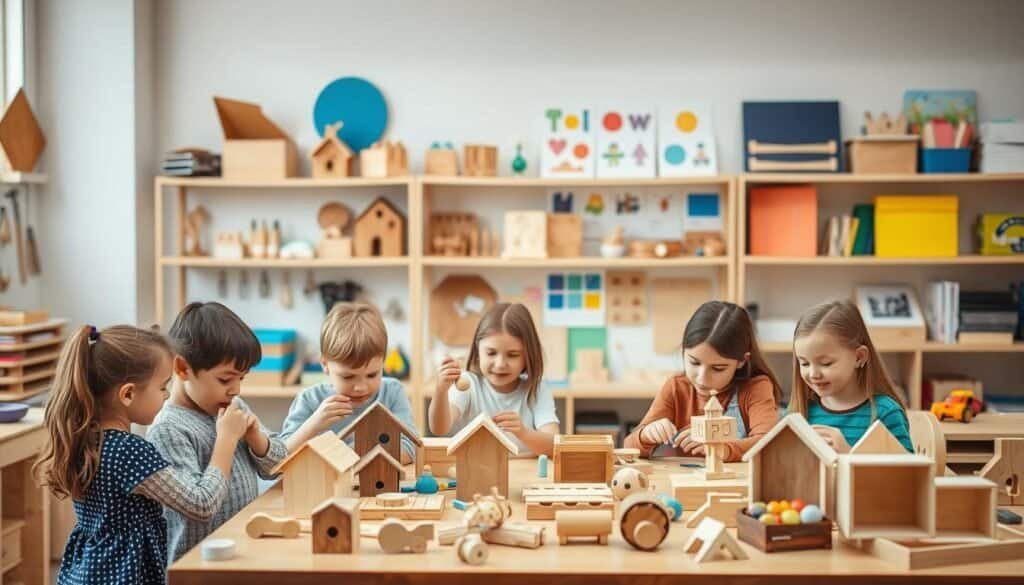
For example, making a wooden birdhouse lets kids apply design principles. They decide on the shape, size, and color. They can try different designs and see what works best.
Doing creative wood crafts also makes kids think about materials and tools. They learn about wood types and how to use tools. They figure out how to solve woodworking problems.
Adding DIY wood projects to learning helps kids understand design well. It also gives them practical skills. This way, kids become more creative and ready for bigger projects later.
Simple Wooden Block Puzzles for Preschoolers
Simple wooden block puzzles are a fun way for preschoolers to learn about shapes and patterns. They are not just entertaining but also help with learning. These puzzles improve thinking and hand skills in young children.
Playing with these puzzles helps kids solve problems. They learn to put pieces together to make a complete picture. This boosts their thinking and understanding of space, which is key for their growth.
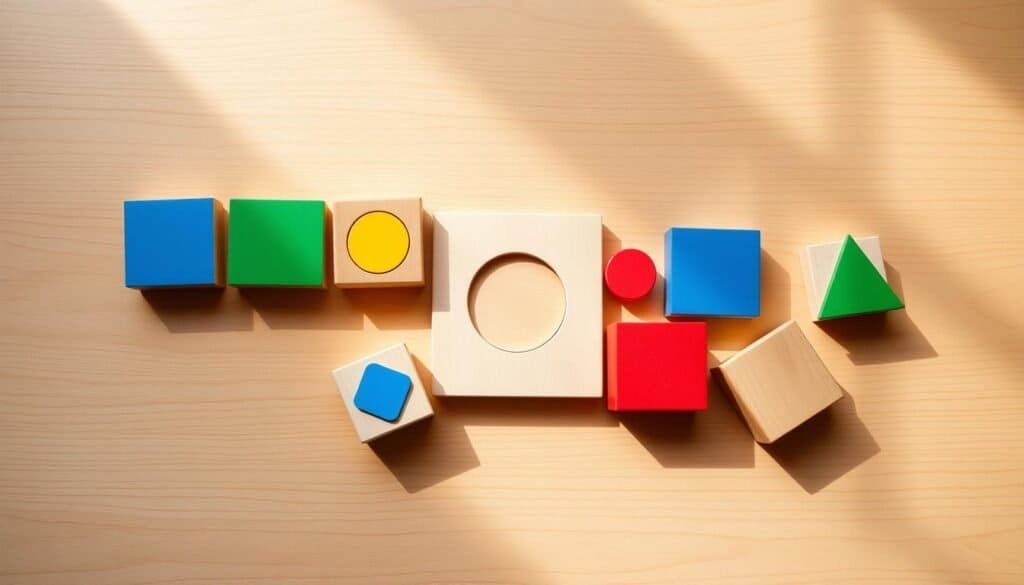
It’s important to make sure the puzzle edges are smooth and safe for little hands. Teaching kids to sand is a great skill. It helps with woodworking and improves their hand-eye coordination and fine motor skills.
Begin with coarse sandpaper and then use finer grits. Show them to sand only in one direction to avoid scratches. This teaches patience and attention to detail, not just about smoothing wood.
Simple wooden block puzzles are a great example of fun and learning. By making these puzzles with preschoolers, parents and teachers offer a full learning experience. It combines creativity with practical skills.
Bird Houses: Combining Nature Study with Woodcraft
Bird house projects mix nature study with woodcraft, giving kids a full learning experience. They learn woodworking and the value of saving wildlife. It’s a fun way to teach them about the outdoors.
Building a bird house is more than just hammering and sawing. It’s a journey that teaches kids about bird habitats and needs. This hands-on learning helps them connect with nature and care for the environment.
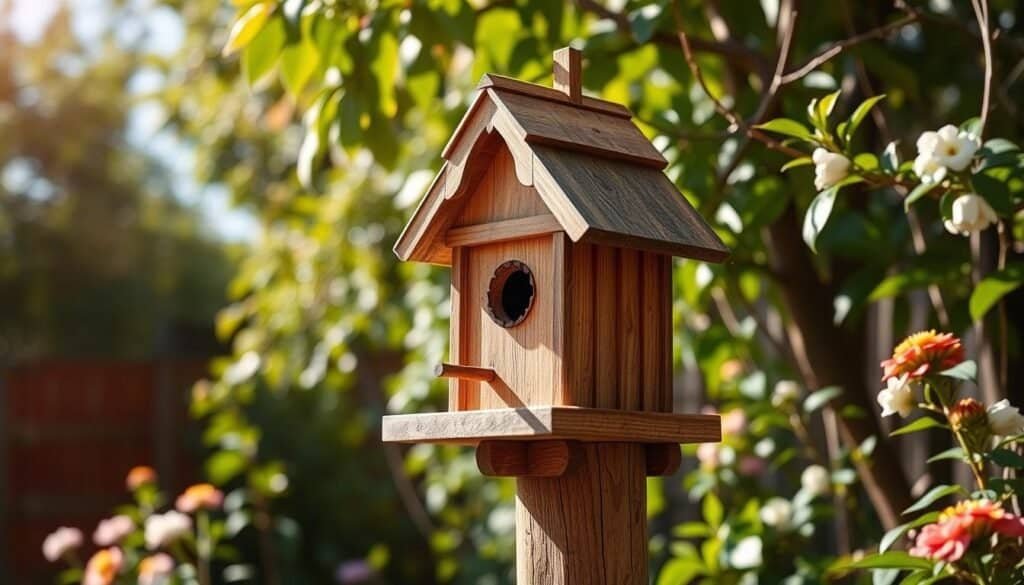
While working on bird house projects, kids learn about measurement and building. They also feel proud of making something useful. These projects help them understand the role of birds in our world and the need for safe homes for them.
Monitoring and Maintenance Lessons
After building and installing the bird houses, the learning continues. Kids can watch the bird houses and see which birds live there. They also learn how to keep these homes safe and welcoming.
This ongoing effort teaches kids about responsibility and caring for wildlife. It shows them the importance of conservation and how humans and wildlife are connected.
Bird house projects give kids a special mix of skills and environmental knowledge. They are a great part of any nature study program.
Wooden Marble Runs: Physics in Action
Physics comes alive when kids make their own wooden marble runs. They learn about gravity, motion, and energy transfer through play. These runs are fun and teach kids a lot.
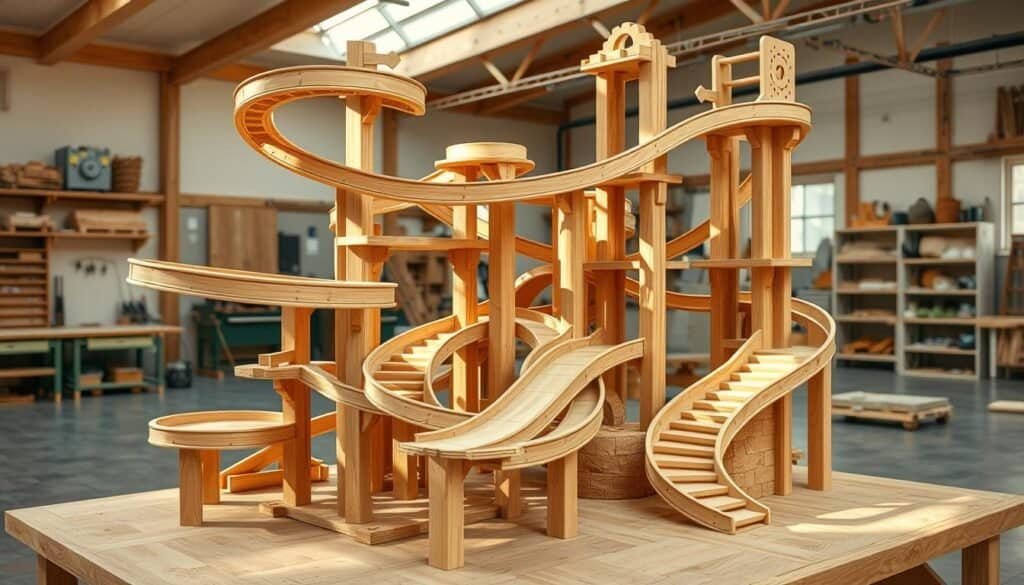
As kids build their marble runs, they try out different designs. They see how ramps, loops, and turns change the marble’s path. This hands-on learning is key to understanding physics.
Adding Complexity for Older Children
Older kids can make their marble runs more challenging. They can add more paths, use timers, or design runs with sudden changes in direction.
These additions make the project more exciting and help kids learn more. They learn about variables, cause and effect, and the scientific method.
DIY wood projects like marble runs help kids solve problems, think creatively, and grasp physics better. It’s a fun way to learn complex ideas, making it a great educational project.
Functional Bookends: Practical Design Projects
Building functional bookends is a fun way for kids to use their design and woodworking skills. It’s a great example of how DIY projects can be both enjoyable and educational.
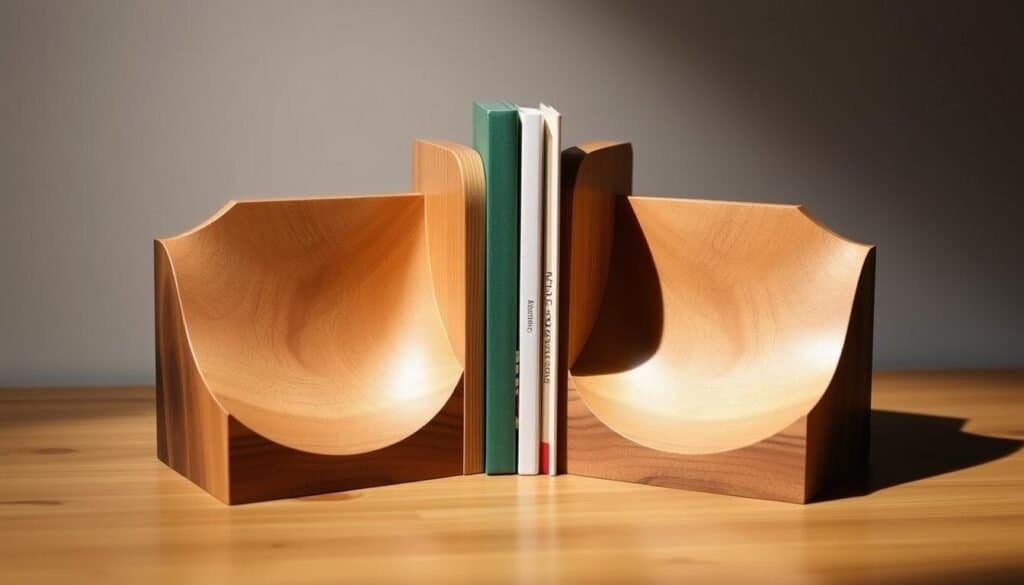
Functional bookends are a fantastic way to teach kids about design. They learn about balance, proportion, and texture. This makes them a great project for learning about aesthetics.
Also, making bookends requires skills like measuring, cutting, and assembling. These skills help kids improve their hand-eye coordination and fine motor skills.
Parents can make this project even more exciting. Encourage kids to try different designs and materials. This lets them be creative and solve problems, making the project a valuable learning experience.
In summary, functional bookends are a great DIY project for kids. They help kids learn design and woodworking skills. It’s a project that can be adapted to fit different skill levels, making it perfect for kids of all ages and abilities.
Wooden Toys That Teach Mechanical Principles
Wooden toys bring mechanical principles to life for kids. Toys like puzzles, marble runs, and gear-based toys teach mechanics hands-on. They’re fun and educational, helping kids grasp complex ideas through play.
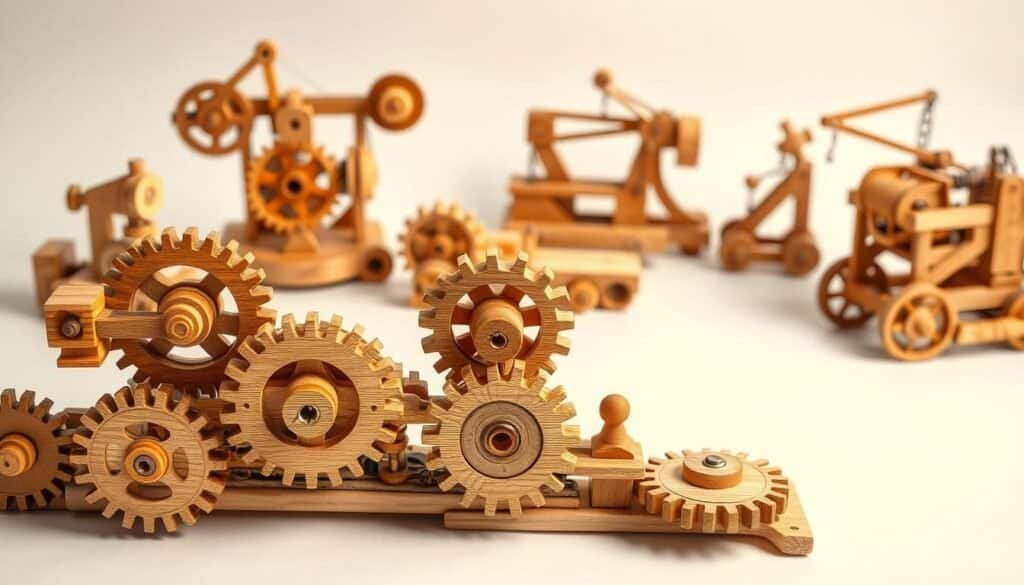
Wooden toys help kids think creatively and solve problems. For example, a marble run teaches kids about cause and effect, gravity, and motion. By trying different setups, they learn how parts work together.
Troubleshooting Movement Issues
When kids play with these toys, they might face problems with movement. Fixing these issues is a key part of learning. It teaches them to analyze problems, find causes, and solve them.
For instance, if a marble run isn’t working right, kids can look for blockages or check the track’s alignment. Making adjustments helps them understand mechanical systems better. This knowledge is useful in many areas, from simple fixes to big engineering projects.
Picture Frames: Precision and Measurement Projects
Creating picture frames is a great way for kids to improve their precision and measurement skills in woodworking. This project needs accurate measurements and precise cuts. It teaches children the importance of detail in woodworking.
When making DIY wooden picture frames, kids learn to measure twice and cut once. This is a key habit in woodworking. They understand how small errors can change the final result.
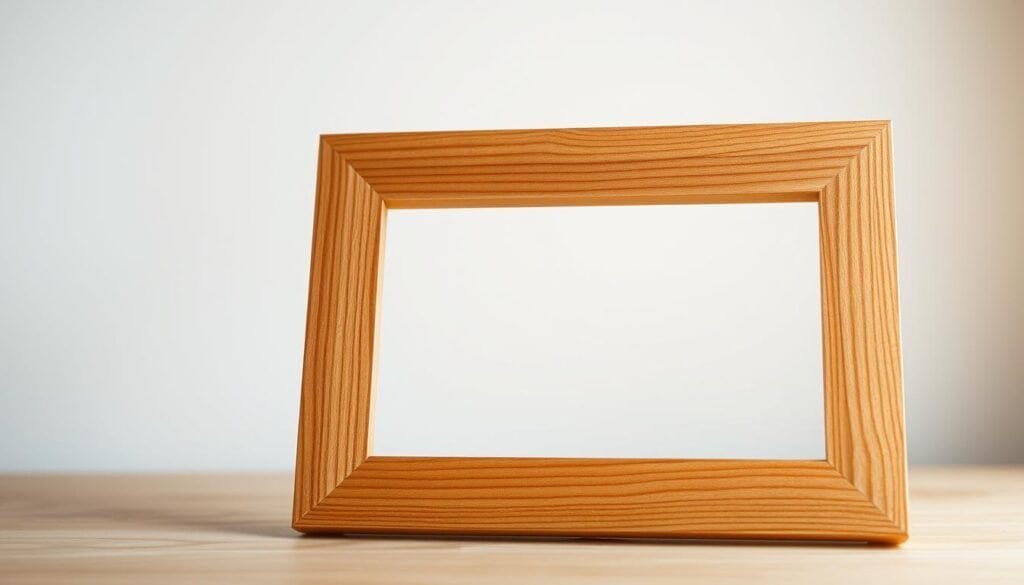
Picture frames are all about precision. Kids will use tools like rulers and calipers to get their measurements right.
Display Options for Finished Work
After finishing the picture frames, kids can show off their work. They can put their favorite photos or artwork in the frames. This makes the project even more special and rewarding.
Showing off their finished picture frames shows kids the value of their hard work. It encourages them to keep exploring woodworking projects.
Small Furniture Projects for Elementary Students
Elementary students can learn about design by making small furniture. They get to understand design principles like scaling in a fun way. These projects also teach woodworking and the practical side of design and measurement.
Projects like building simple stools, small tables, or shelves are great for kids. They help students think about scale and proportion. This means they learn to turn their designs into real furniture.
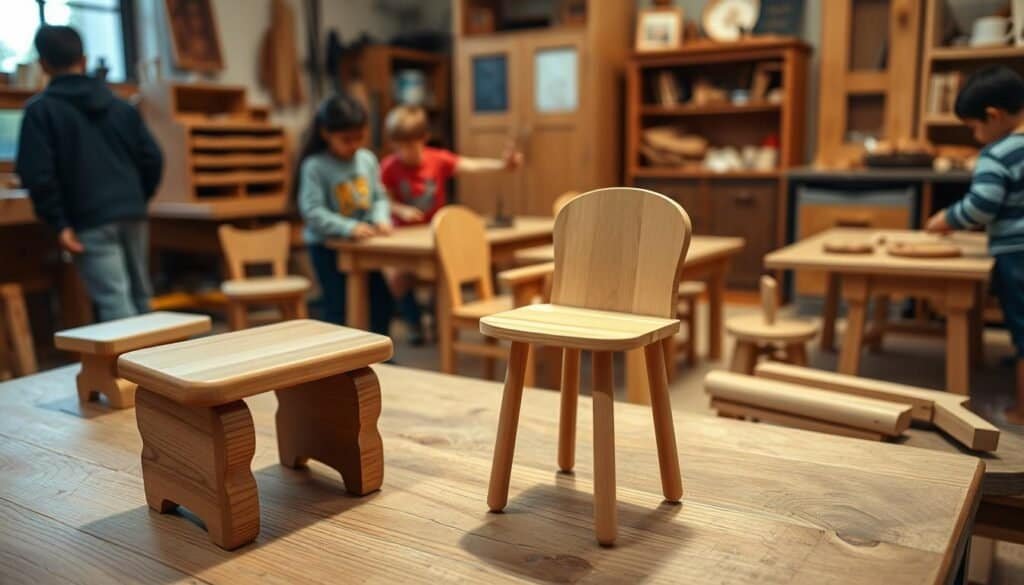
Working on these projects, students learn the value of measuring and being precise. They see that changing size means adjusting dimensions but keeping the design true.
Scaling Concepts for Young Designers
Scaling is key in design, letting students adapt their ideas to various sizes. Through small furniture projects, elementary students get to practice this.
For example, when making a small table, students must think about the size of the legs and the surface. This hands-on learning helps them understand design better.
Wooden Musical Instruments: Sound and Design
Making wooden musical instruments is a mix of creativity and technical skills. It teaches kids about sound and design. This can be a fun way for them to learn about music and improve their crafting skills.
Wooden instruments like xylophones, guitars, and drums combine sound and beauty. Kids learn about sound science and design. They see how to make something that sounds good and looks great.
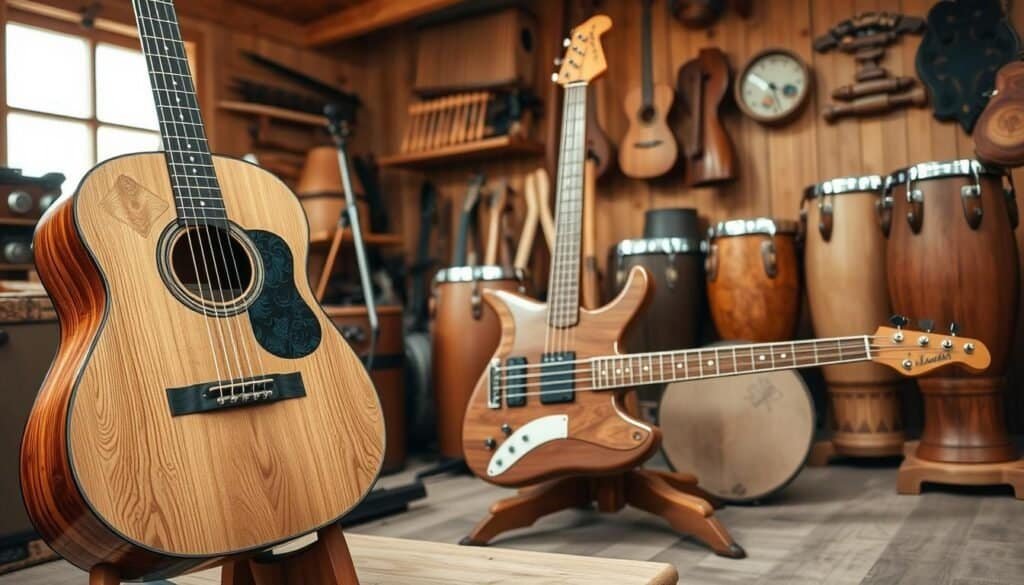
These projects help kids develop skills like measuring, cutting, and assembling wood. They improve their fine motor skills and hand-eye coordination.
Cultural Music Connections
Wooden instruments can also introduce kids to different cultures. For instance, the djembe drum from West Africa, the sitar from India, and the marimba from Central and South America have deep cultural roots. By making these, kids can discover various musical traditions and their cultural backgrounds.
This hands-on music education can make kids appreciate global music diversity. It’s a fun way to learn about history, culture, and instrument-making.
Collaborative Family Projects for Deeper Learning
Woodworking projects as a family do more than just teach skills. They also bring families closer together. Working on DIY wood projects, everyone gets to share ideas and learn from each other. They feel proud of what they’ve accomplished together.
These projects let kids explore their creativity and learn woodworking and design. Family members can talk about measurement, geometry, and physics as they work. This makes learning fun and hands-on.
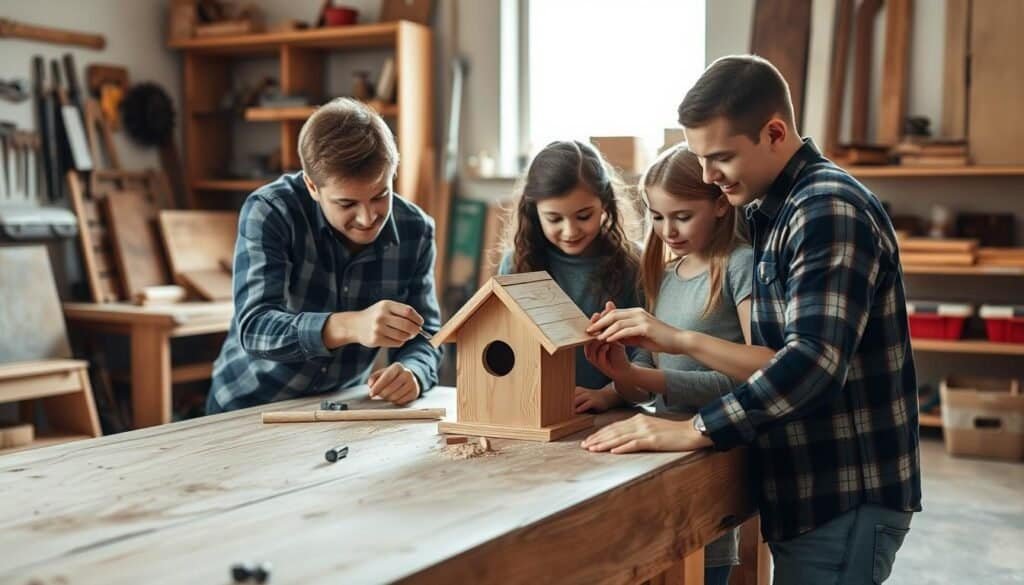
Parents also learn a lot by guiding their kids. They teach patience, teamwork, and problem-solving. Working on projects together, families make lasting memories. They appreciate the skill of making something with their own hands.
Upcycling Wood Scraps: Sustainability in Design
Upcycling wood scraps is a cool way to teach kids about green design. It turns waste into amazing projects. This way, kids learn about being eco-friendly in a fun way.
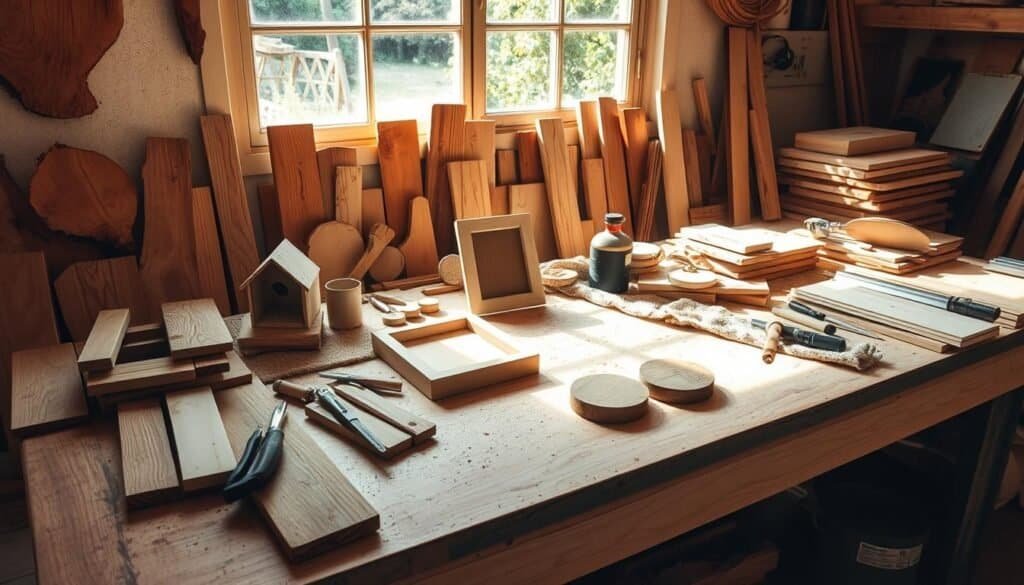
This method also boosts creativity and resourcefulness. Kids can make all sorts of things, like decorations or useful items. They use wood scraps that would have been thrown away.
From Waste to Wonderful
Upcycling wood scraps teaches kids to think creatively about waste and being green. It’s a great way to teach them about caring for the environment.
Through upcycling, kids learn to appreciate the materials they use. They see how their actions affect the planet. This knowledge helps them grow up to be more eco-friendly.
Conclusion: Building Skills That Last a Lifetime
Doing DIY wood projects with kids can change their lives. It teaches them skills that last forever. Woodworking helps kids solve problems, improve hand-eye coordination, and think creatively.
Woodworking also boosts their understanding of design and mechanics. It teaches them patience and perseverance. This makes learning fun and builds a strong family bond.
As kids work on more projects, they feel more confident. They learn to solve problems and feel proud of what they make. These skills and the joy of creating will stay with them always.
Introducing kids to woodworking gives them a great start in life. It encourages them to be creative, innovative, and express themselves. The benefits of woodworking for kids are huge, making it a great activity for families to do together.

